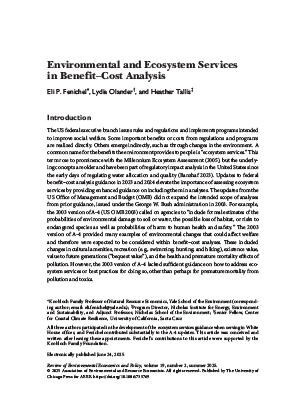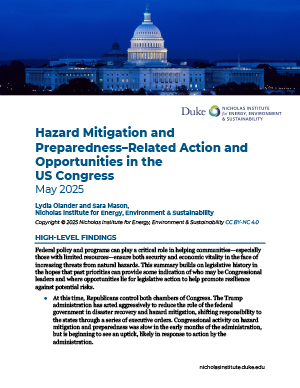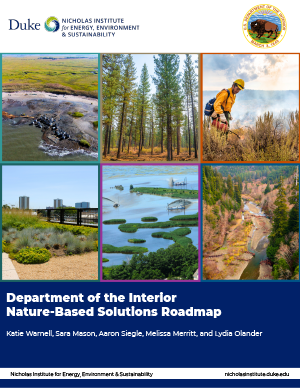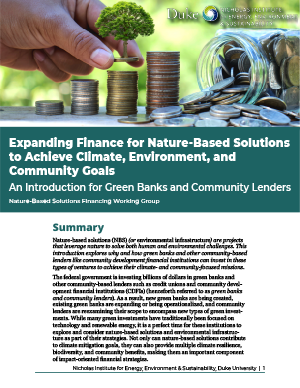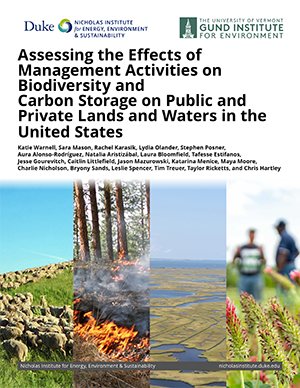Publications
Environmental and Ecosystem Services in Benefit–Cost Analysis
Recent federal updates and activities modernizing regulation have elevated the importance of ecosystem services and clarified guidance for accounting for their value. These changes underscore the crucial role of ecosystem services in federal benefit–cost analysis, provide clear entry points that make it simplify and enhance transparency for agencies and stakeholders to include ecosystem services in benefit–cost analysis, and document advances in the literature demonstrating that ecosystem services can be credibly and robustly included in such analyses.
Hazard Mitigation and Preparedness–Related Action and Opportunities in the US Congress
Federal policy and programs can play a critical role in helping communities—especially those with limited resources—ensure both security and economic vitality in the face of increasing threats from natural hazards. This summary builds on legislative history in the hopes that past priorities can provide some indication of who may be Congressional leaders and where opportunities lie for legislative action to help promote resilience against potential risks.
America Prepared: A New Approach—Building a Nation Prepared for Extreme Weather
Federal policy and programs can play a critical role in helping communities—especially those with limited resources—ensure both security and economic vitality in the face of increasing threats from natural hazards. But to get there, the federal government needs a more coordinated approach to empower state and local governments, as well as local institutions and private-sector partners that are working hand in hand with homeowners, businesses, and local and Tribal governments. In this brief, the authors recommend four critical proactive actions the federal government could take to effectively and cost-efficiently prepare the nation for these extreme events and reduce their catastrophic impacts.
Challenges and Solutions to Permitting Living Shoreline Projects
Despite growing interest and investment in nature-based solutions such as living shorelines in the United States, it has been difficult to expand their use. One major hurdle is permitting challenges. Florida, North Carolina, and Virginia are three states where living shoreline installations have increased. We examined what policy conditions exist in these locations to enable project permitting, as well as how to address any remaining hurdles.
Advancing Consistent Socio-Economic Monitoring of Coastal Ecosystem Restoration Through Collaborative Metric Development
Ecological restoration programs increasingly aim to provide socioeconomic and environmental benefits. However, monitoring of socioeconomic outcomes of these programs lags behind monitoring of ecological outcomes. Socioeconomic methods are less established, managers have less experience, and metrics used vary, stymieing evaluation and adaptive management. Here we demonstrate that logic models and stakeholder engagement can be used to identify core socioeconomic metrics across various types of restoration, focusing on coastal restoration in the Gulf of Mexico.
Evaluation of Publicly Accessible Nature-Based Solutions Databases as Sources for Evidence of Effectiveness
Nature-based solutions (NBS) address societal challenges by managing ecosystems to provide environmental and human benefits. This report assesses 27 publicly accessible databases on NBS research and projects, highlighting their utility as well as limitations and gaps in coverage. Key recommendations include making databases downloadable, adding standardized geographic and project attributes, and improving measurement of effectiveness. Better data accessibility and consistency are essential for developing design standards and scaling up NBS implementation.
Department of the Interior Nature-Based Solutions Roadmap
This comprehensive resource, created in collaboration with the US Department of the Interior, is a first-of-its-kind reference for implementing nature-based solutions. Nature-based solutions are actions to protect, sustainably manage or restore natural or modified ecosystems to address societal challenges—including climate change—in ways that help people and the environment. Examples cited in the Roadmap range from urban stormwater and runoff management to prescribed burns to living shorelines to restoration of various ecosystems.
Financing Nature-Based Solutions via the Greenhouse Gas Reduction Fund
The $27 billion Greenhouse Gas Reduction Fund (GGRF) in the Inflation Reduction Act—particularly the $14 billion National Clean Investment Fund and $6 billion Clean Communities Investment Accelerator—represents a once-in-a-generation opportunity to leverage private capital for investments in environmental infrastructure and nature-based solutions, but the groundwork needs to be laid now. This document summarizes the relevant GGRF funds and their applicability for nature-based solutions.
Expanding Finance for Nature-Based Solutions to Achieve Climate, Environment, and Community Goals: An Introduction for Green Banks and Community Lenders
There has been unprecedented recent government investment in nature-based solutions. This document lays out a vision that describes why nature-based solutions are relevant and important to green banks' and community development financial institutions' climate- and community-driven missions, and what types of projects these institutions might support.
Assessing the Effects of Management Activities on Biodiversity and Carbon Storage on Public and Private Lands and Waters in the United States
Natural and working lands (NWLs) provide many benefits to people, including storing greenhouse gases (GHGs), supporting biodiversity, and generating other ecosystem services. Management of NWLs can influence their condition and function and therefore the benefits they provide. This project surveys the synthesis literature to assess how management actions on various types of NWLs affect biodiversity and GHG outcomes. This information can help to determine how to best manage these lands to contribute to both biodiversity and climate solutions in the United States.

